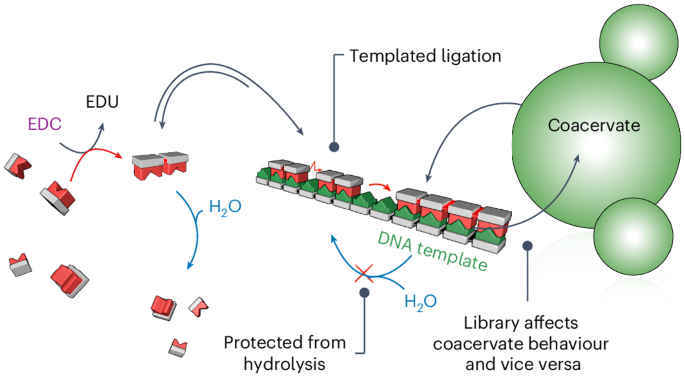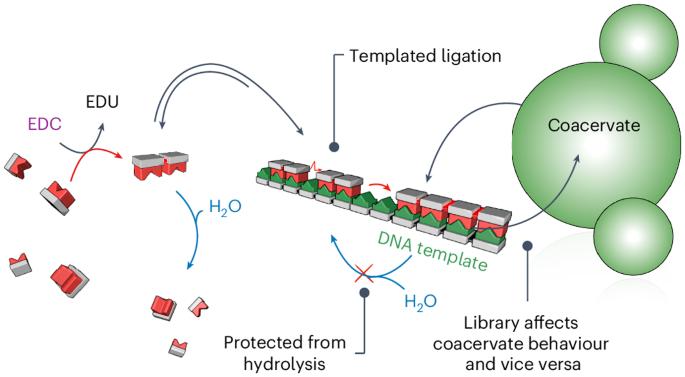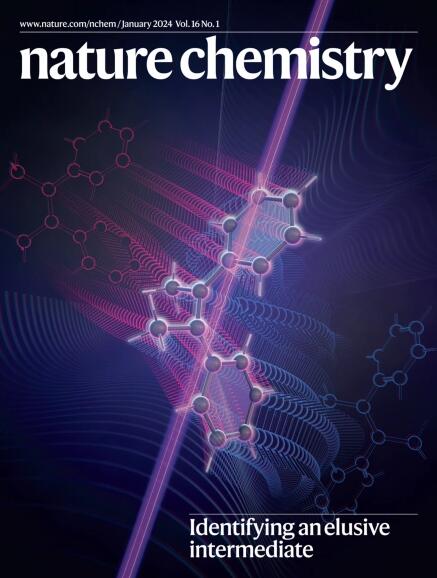基于模板的化学动态组合库复制
IF 19.2
1区 化学
Q1 CHEMISTRY, MULTIDISCIPLINARY
引用次数: 0
摘要
科学最大的挑战之一是确定生命如何从分子混合物中自发产生。一个复杂的因素是,生命及其分子本身并不稳定--核糖核酸和蛋白质容易水解和变性。为了从头合成生命或更好地理解生命起源,不稳定分子需要选择机制。在这里,我们提出了一个以化学为动力的动态组合库来模拟 RNA 的低聚物化和脱低聚物化,并为动力学控制下的选择和纯化机制提供了新的启示。在实验中,低聚物只能通过持续生产来维持。杂交是选择不稳定分子的有力工具,可对寡聚和脱寡聚率提供反馈。此外,我们还发现模板化技术可用于纯化低聚物库。此外,模板辅助形成的低聚物在基于共凝胶的原胞中会改变其隔室的物理性质,如融合能力。这种低聚物生产与物理特性之间的相互耦合是实现合成生命的关键一步。本文章由计算机程序翻译,如有差异,请以英文原文为准。


Template-based copying in chemically fuelled dynamic combinatorial libraries
One of science’s greatest challenges is determining how life can spontaneously emerge from a mixture of molecules. A complicating factor is that life and its molecules are inherently unstable—RNA and proteins are prone to hydrolysis and denaturation. For the de novo synthesis of life or to better understand its emergence at its origin, selection mechanisms are needed for unstable molecules. Here we present a chemically fuelled dynamic combinatorial library to model RNA oligomerization and deoligomerization and shine new light on selection and purification mechanisms under kinetic control. In the experiments, oligomers can only be sustained by continuous production. Hybridization is a powerful tool for selecting unstable molecules, offering feedback on oligomerization and deoligomerization rates. Moreover, we find that templation can be used to purify libraries of oligomers. In addition, template-assisted formation of oligomers within coacervate-based protocells changes its compartment’s physical properties, such as their ability to fuse. Such reciprocal coupling between oligomer production and physical properties is a key step towards synthetic life. Selection mechanisms were critical at the emergence of life and will also be important for the synthesis of life. Now, it has been shown that template-based copying controls the selection of unstable molecules in a chemically fuelled dynamic combinatorial library. Moreover, when encapsulated inside coacervate droplets, these mechanisms change the coacervate’s physical properties.
求助全文
通过发布文献求助,成功后即可免费获取论文全文。
去求助
来源期刊

Nature chemistry
化学-化学综合
CiteScore
29.60
自引率
1.40%
发文量
226
审稿时长
1.7 months
期刊介绍:
Nature Chemistry is a monthly journal that publishes groundbreaking and significant research in all areas of chemistry. It covers traditional subjects such as analytical, inorganic, organic, and physical chemistry, as well as a wide range of other topics including catalysis, computational and theoretical chemistry, and environmental chemistry.
The journal also features interdisciplinary research at the interface of chemistry with biology, materials science, nanotechnology, and physics. Manuscripts detailing such multidisciplinary work are encouraged, as long as the central theme pertains to chemistry.
Aside from primary research, Nature Chemistry publishes review articles, news and views, research highlights from other journals, commentaries, book reviews, correspondence, and analysis of the broader chemical landscape. It also addresses crucial issues related to education, funding, policy, intellectual property, and the societal impact of chemistry.
Nature Chemistry is dedicated to ensuring the highest standards of original research through a fair and rigorous review process. It offers authors maximum visibility for their papers, access to a broad readership, exceptional copy editing and production standards, rapid publication, and independence from academic societies and other vested interests.
Overall, Nature Chemistry aims to be the authoritative voice of the global chemical community.
 求助内容:
求助内容: 应助结果提醒方式:
应助结果提醒方式:


